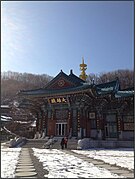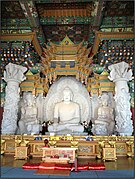
Guanyin is a Bodhisattva associated with compassion. She is the East Asian representation of Avalokiteśvara and has been adopted by other Eastern religions, including Chinese folk religion. She was first given the appellation "Goddess of Mercy" or "Mercy Goddess" by Jesuit missionaries in China. Guanyin is short for Guanshiyin, which means "[The One Who] Perceives the Sounds of the World." On the 19th day of the sixth lunar month, Guanyin's attainment of Buddhahood is celebrated.

The Seokguram Grotto is a hermitage and part of the Bulguksa temple complex. It lies four kilometers east of the temple on Mt. Tohamsan, in Gyeongju, South Korea. It is classified as National Treasure No. 24 by the South Korean government and is located at 994, Jinhyeon-dong, Gyeongju-si, Gyeongsanbuk-do. The grotto overlooks the Sea of Japan and rests 750 meters above sea level. In 1962, it was designated the 24th national treasure of Korea. In 1995, Seokguram was added to the UNESCO World Heritage List together with the Bulguksa Temple. It exemplifies some of the best Buddhist sculptures in the world.

A National Treasure is a tangible treasure, artifact, site, or building which is recognized by the South Korean government as having exceptional artistic, cultural and historical value to the country. The title is one of the eight State-designated heritage classifications assigned by the administrator of the Cultural Heritage Administration (CHA) in accordance with the Cultural Heritage Protection Act after deliberation by the Cultural Heritage Committee.
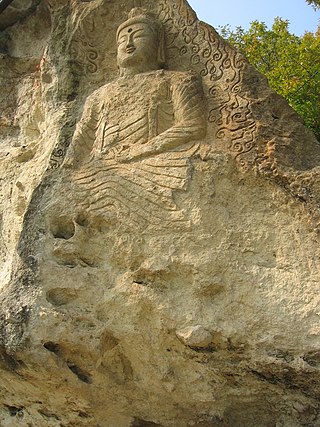
Golgulsa is located 20 km east of the ancient Silla Dynasty capital city of Gyeongju in Southeastern Korea. In the Golgulsa temple area can be found the oldest historical Buddhist ruins on Mt. Hamwol and the only cave temple in Korea.
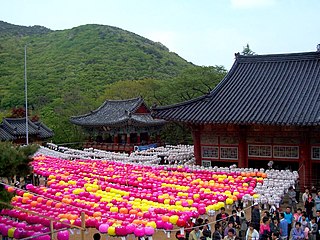
Beomeosa is a head temple of the Jogye Order of Korean Buddhism in Cheongnyong-dong, Geumjeong-gu, Busan, South Korea. Built on the slopes of Geumjeongsan, it is one of the country's best known urban temples.
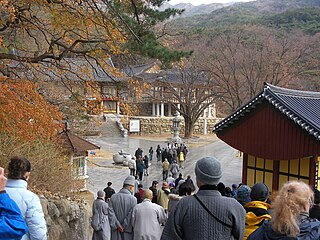
Donghwasa, also Donghwa Temple, is a Buddhist temple of the Jogye Order in northern Daegu, South Korea. The temple is located on the south side of Mt. Palgongsan, within the boundaries of Dohak-dong, Dong-gu, near Daegu's northern border. The name means "Temple of Paulownia Blossoms."
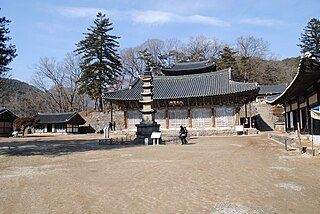
Magoksa is a head temple of the Jogye Order of Korean Buddhism in Gongju, South Korea. It is located on the eastern slope of Taehwasan, on taegeuk-shaped bend in the Taegeukcheon Stream.

Beopjusa is a head temple of the Jogye Order of Korean Buddhism. It is situated on the slopes of Songnisan, within Songnisan National Park, in Naesongni-myeon, Boeun County, in the province of Chungcheongbuk-do, South Korea.

Woljeongsa is a head temple of the Jogye Order of Korean Buddhism, located on the eastern slopes of Odaesan in Pyeongchang County, Gangwon Province, South Korea. Woljeongsa was founded in 643 by the Silla monk Jajang.

Yongjoosa is a head temple of the Jogye Order of Korean Buddhism. It is located in on the slopes of Hwasan in Taean-eup, Hwaseong, in the province of Gyeonggi, South Korea. The temple's name means "dragon jewel temple."

Hwaeomsa is a head temple of the Jogye Order of Korean Buddhism. It is located on the slopes of Jirisan, in Masan-myeon, Gurye County, in South Jeolla Province, South Korea.

Guinsa, in the Yeonhwa area of the Sobaek Mountains located near Danyang in Chungcheongbuk-do, South Korea, is the headquarters of the Cheontae school of Korean Buddhism. Guinsa is the administrative center of over 140 sub-temples and hermitages of the Cheontae sect.

Baekdamsa is a Buddhist temple in Inje County, Gangwon province, South Korea. It was originally built in the 7th century, but because of war and natural disasters has been rebuilt numerous times since then. The present version was completed in 1957. Additionally, the name has also changed over time. Originally called Hangyesa, the new name reflects the "100 pits from Daecheongbong Peak to the temple".

Naksansa or Naksan Temple is a Korean Buddhist temple complex in the Jogye order of Korean Buddhism that stands on the slopes of Naksan Mountain. It is located about midway between Sokcho and Yangyang, Gangwon Province, eastern region of South Korea. Naksansa is one of the few temples in Korea to overlook the Sea of Japan.

The Fo Guang Shan Buddha Museum, formerly known as the Buddha Memorial Center, is a Mahāyāna Buddhist cultural, religious, and educational museum located in Dashu District, Kaohsiung, Taiwan. The museum is affiliated with Fo Guang Shan, one of Taiwan's largest Buddhist organizations. The museum is located next to the Fo Guang Shan Monastery, the headquarters of the order. The museum houses one of the tooth relics of Sakyamuni Buddha, the founder of the Buddhist faith. The museum was accepted as the youngest member of the International Council of Museums (ICOM) in 2014.

Myogaksa Temple is a Korean Buddhist temple located in the heart of downtown Seoul, South Korea, in the Jongro District, nestled on the east side of Naksan Mountain. It houses the administrative headquarters of the Gwaneum Order of Korean Buddhism. It is located close to the Dongmangbong Peak, Naksan Park, Donggwanmyo Shrine and Dongdaemun Market.

Naesosa, or Naeso Temple, is a Korean Buddhist Temple located at the base of Naebyeongsan (mountain) in Jinseo-myeon, (township), Buan-gun (county), Jeollabuk-do (province), South Korea.

Samhwasa is a Buddhist temple of the Jogye Order in Gangwon, South Korea.

Banyasa is a Buddhist temple of the Jogye Order in Chungcheong, South Korea.
Dogapsa is a Buddhist temple in South Jeolla Province in Yeongam County, South Korea.


